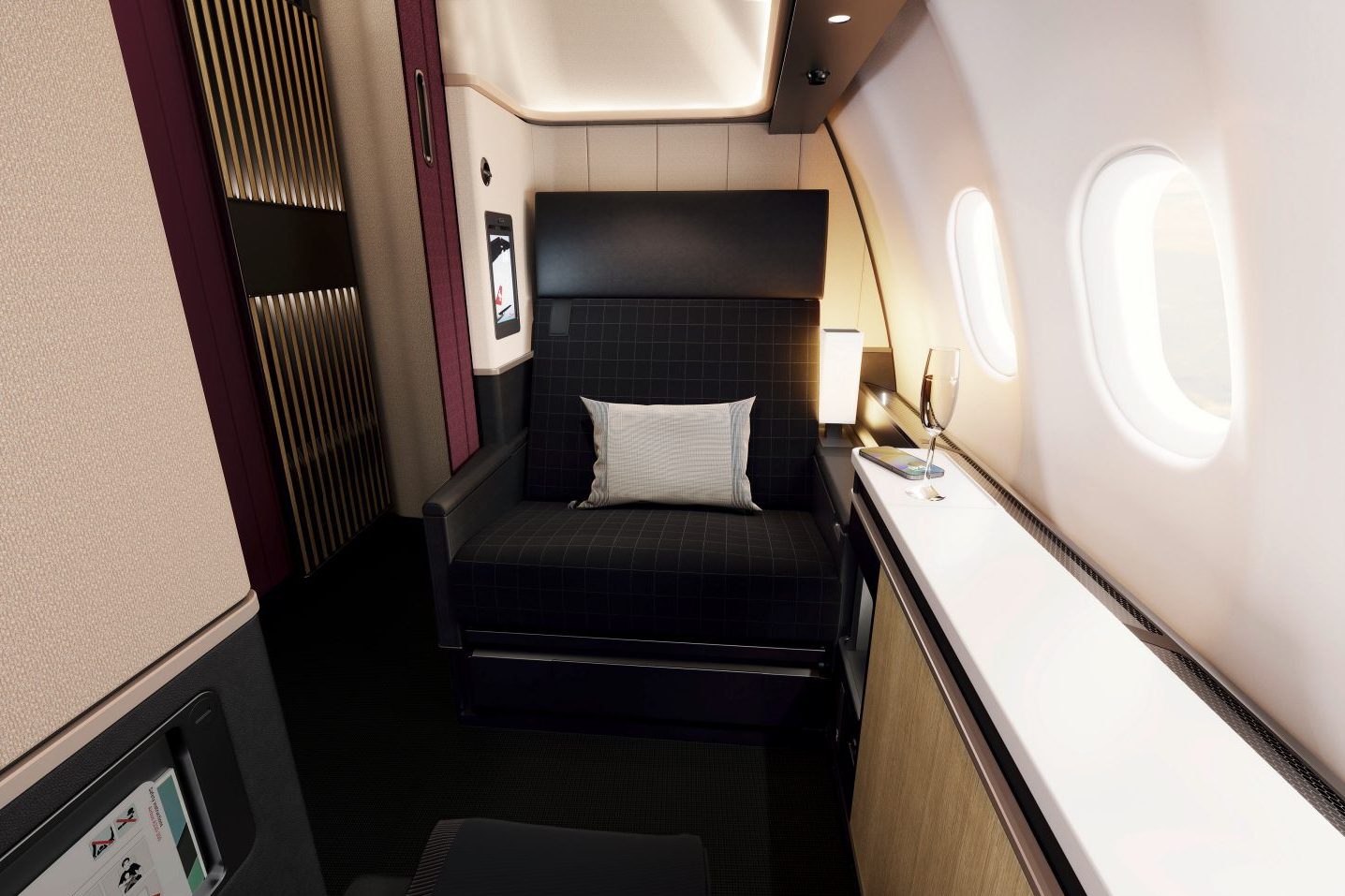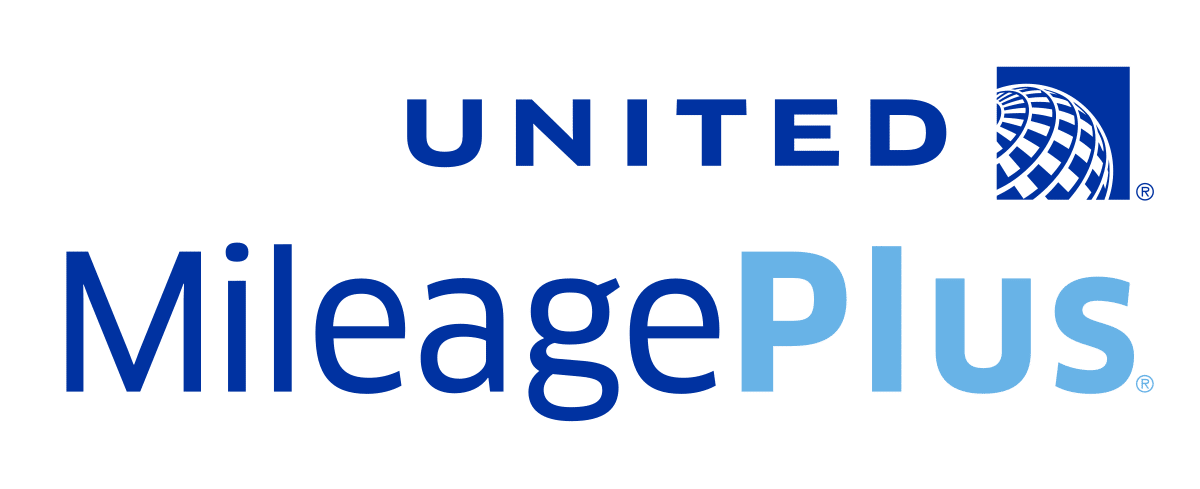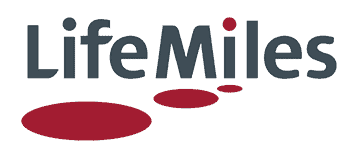Swiss is well-regarded for its elegant business class cabin, as well as its food and drink offering. Likewise, the airline is known for reliably releasing business class awards to its own frequent flyer program, Miles & More, as well as its partners, such as Aeroplan.
In this guide, we’ll show you what the Swiss business class experience is like, and how you can fly the cabin with a Miles & Points strategy.
The Swiss Business Class Experience
Ground Experience
At Swiss’s global hub in Zurich, business class passengers are provided an entire row of check-in counters for their exclusive use with First Class passengers.
Then, before departure (or during transfer), you’ll be invited to a Swiss Business Lounge at the concourse you’re flying from. There are two of them currently open — one at Concourse E and the newer one at Concourse A. Additionally, there’s a newly opened Swiss Alpine Lounge at Concourse A.

In these aesthetically-pleasing lounges, you can find a live cooking station, a cold buffet, as well as a fully stocked bar. If you’re coming in from a long flight, you’ll appreciate the relax area with loungers and showers.

You can “upgrade” to one of the Swiss Senator Lounges if you also Star Alliance Gold status on Swiss or a partner airline.
In terms of amenities and offerings, there aren’t many differences between a Senator Lounge and a Business Lounge, but you’d likely have a more exclusive experience at Senator Lounges with the higher access qualification.

If you’re arriving on a long-haul flight in the morning until noon, you’ll also have access to the Swiss Arrival Lounge. There, you’ll have the chance to enjoy a meal and take a shower before hitting the city.
Seats
Swiss and its parent Lufthansa made headlines recently for their planned respective business class revamps. In 2025 onwards, Swiss will launch Swiss Senses, a renewed cabin experience that includes business class seats with sliding doors.
For now, you’ll get to experience Swiss’s current intercontinental business class seats, which you’ll find to be comfortable nonetheless.
Found on widebody Airbus A330/A340, and Boeing 777 aircraft, Swiss’s intercontinental business class seats are positioned rather uniquely — they follow an alternating 1-2-1 and 2-2-1 arrangement. We’ll go through the configuration in detail below.

Decked in neutral colours and woodgrain finishes, the seats transform into a two-meter flat bed with a massage function, and they’re equipped with several power and USB power ports. Waiting on each seat is an amenity kit by renowned Swiss pocket knife maker Victorinox.

On the other hand, Swiss’s intra-Europe business class is basically economy seats with a blocked adjacent seat, like its most of its European competitors. While many say it’s not a true business class product, you’ll find solace in front of the cabin without anyone beside you when economy in the back is full.
Food and Drink
Swiss is noted for its inflight catering. For one, it has what it calls the Taste of Switzerland concept, which showcases specialties of different regions or “cantons” of the country onboard.

For instance, in collaboration with Michelin-starred restaurant After Seven and the Diner’s Club, Swiss has served cheese-crusted veal tenderloin and vegetarian Tikka masala to highlight the canton of Valais.

Swiss also offers a meal pre-ordering service where you can select your main meal up to 24 hours before departure. You can choose mouthwatering dishes, such as chicken fricassée in Pinot Noir sauce or sliced veal Zurich-style.

Swiss Business Class Cabin
Intercontinental Business Class (Airbus A330/A340 and Boeing 777)
Swiss utilizes wide-body Airbus A330, A340, and Boeing 777 aircraft for its intercontinental routes, and all of them are configured in an alternating 1-2-1 and 2-2-1 staggered configuration.

This configuration means that on the left side of the cabin, there are solo “throne” seats staggered by a pair of seats behind them.
These throne seats offer plenty of real estate, so they’re arguably the best seats on the plane. However, they’re only available to Miles & More HON Circle or Senator members, until 48 hours before the flight when they’re open to everyone else.

If you don’t manage to snag a throne seat on the A330 or A340, you’ll still have the right side with a column of solo seats (“K” seats). The seats nearer to the window have the console separating them from the aisle, thus offering a bit more privacy, than the seats nearer to the aisle.

For couples, you may choose any of the paired seats. However, none of them are close “honeymoon” seats, since they’re separated by a console and a retractable centre partition.

European Business Class (Airbus A321/A320/A220)
Within Europe, Swiss deploys its narrow-body Airbus A321, A320, and A220 aircraft. Again, on its narrow-body aircraft, business class practically means economy seats with a blocked adjacent seat in the first few rows of the aircraft. Offered by almost all European carriers, a “European business class” product affords airlines the flexibility to add or reduce business class rows, as needed.

On newer A321 aircraft, all business class seats offer 34” seat pitch or legroom. However, on other aircraft, the seat pitch is similar to economy seats, except for row 1, which offers more room due to the bulkhead.

On smaller A220 aircraft, the configuration is 2-3. If you’re flying solo, you should choose one of the “A” seats on the left side, so you can have a blocked seat beside you.

Swiss Business Class Routes
You can expect business class to bookable on all Swiss flights. However, as we’ve discussed above, your experience will vary on a longer intercontinental flight versus a shorter intra-Europe flight.
In the US, Swiss flies its intercontinental business class to six cities, including New York, where it flies from both Zurich and Geneva to ferry UN diplomats and employees. Meanwhile, in Canada, it only flies nonstop to Montreal.

From its hub in Zurich, Swiss flies to several destination in Asia, including Bangkok, Singapore, and Mumbai, making one-stop connections from North America possible.
How to Redeem Points for Swiss Business Class
Swiss shares its frequent flyer program called Miles & More with other Lufthansa Group carriers, including Austrian Airlines and Brussels Airlines.

It follows a dynamic pricing model for flights solely involving the Lufthansa group, and a hidden zone-based chart for awards involving Star Alliance partner flights.
Unfortunately, it’s harder to accrue Swiss/Lufthansa miles through credit cards, since it virtually has no transfer partners in Canada nor the US. There’s the option of transferring Marriott Bonvoy points, but the lacklustre 3,000 Bonvoy points = 1,000 miles conversion rate hardly makes it worthwhile.
Those who have access to the US credit card market, however, may look into the Miles & More World Elite Mastercard from Barclays that usually offers 60,000 miles as a welcome bonus.

If you’re not keen on collecting Swiss/Lufthansa miles, you can always book Swiss business class through Star Alliance partners — some of which we’ll detail below.
Air Canada Aeroplan
Through Aeroplan, you can redeem Swiss awards based on a distance and zone-based charts for partner flights. On the redemption charts, Canada and the US are in the North America zone, while Europe is in the Atlantic zone.

Given the chart above, a one-way business class seat from New York to Geneva costs 60,000 Aeroplan points plus $76 (CAD) in taxes. At approximately 3,860 miles, the great-circle distance between the two cities places it right under the 0–4,000 distance band for Aeroplan awards, making it a “sweet spot” for redemption.

To recall, Aeroplan points can be collected by transferring from credit card programs, such as American Express Membership Rewards. There also are Aeroplan co-branded cards in both Canada and the US.
| Credit Card | Best Offer | Value | |
|---|---|---|---|
|
70,000 MR points
$250 annual fee
|
70,000 MR points | $1,676 | Apply Now |
|
120,000 MR points
$799 annual fee
|
120,000 MR points | $1,574 | Apply Now |
|
75,000 MR points
$199 annual fee
|
75,000 MR points | $1,561 | Apply Now |
|
Up to 77,000 MR points
$99 annual fee
|
Up to 77,000 MR points | $1,419 | Apply Now |
| 100,000 MR points | $1,361 | Apply Now | |
| 15,000 MR points | $372 | Apply Now |
United MileagePlus
United MileagePlus doesn’t follow fixed redemption charts, even with flights on partners, so Swiss business class awards are subjected to dynamic pricing.
To find out how many miles you’ll need, you must go through United’s flight search engine. For example, the same New York to Geneva flight above yields a cost of 73,000 miles plus $5.60 (USD) in taxes.

United doesn’t have credit card transfer partners in Canada. Hence, collecting United miles is more geared towards those in the US, where Chase issues co-branded credit cards and enables transfers from Chase Ultimate Rewards.
Avianca LifeMiles
Lastly, you may have heard of Avianca LifeMiles because of its generous miles purchase promotions. Booking partner flights on the program follows the same geographic zone-based chart as Avianca flights.
Using the same example above, a one-way Swiss business class seat from New York to Geneva costs only 63,000 LifeMiles plus US$26.70 in taxes.

LifeMiles doesn’t have a transfer partner in Canada, but in the US, you can transfer points from American Express US Membership Rewards, Capital One Miles, and Citi ThankYou Rewards.
Swiss Business Class Award Availability
With Swiss and Lufthansa’s Miles & More program, you’ll have better chances of finding reward availability, because of the program’s dynamic pricing. Dynamic pricing enables airlines to offer more seats, albeit at variable redemption costs.
Unfortunately, you can’t do a speculative search on the Miles & More website, unless you have 7,000 miles, which the minimum cost of an award flight.

Partners like Air Canada, on the other hand, share the same Swiss “saver award” inventory. Partners don’t usually impose a dynamic pricing model on their partners’ flights, but you’re understandably limited to fewer seats.
The good thing is, Swiss is relatively reliable in releasing business class awards to its partners, so make sure to constantly check the flights you want — especially when bookings first open up or at the last minute.
Tips & Tricks for Swiss Business Class
Book Early or Check Last-Minute Availability
Across different Star Alliance carriers, reward bookings usually open up 330-355 days before departure. Since partner carriers share “saver award” space, it’s prudent to check availability as soon as the window opens up if you already have dates in mind.
However, if you’re planning a spontaneous trip, it’s worth checking out trans-Atlantic business class availability on Swiss, since the airline also releases award seats closer to the date. Some searches may even yield many (i.e., not just two) award seats, like the New York to Zurich example below.

To help you with your search, you can use a tool like ExpertFlyer, or you could also use Avianca LifeMiles’s calendar search function, which shows saver awards on partners.

Intra-Europe Flights
You should always keep in mind that business class on intra-Europe flights are basically economy seats with a blocked adjacent seat. That said, if adding an extra leg would cost more miles on a distance-based redemption, you should do a cost-benefit analysis.
A good example would be on Aeroplan. A business class seat from New York to either Geneva or Zurich sits right below the 0–4,000 miles redemption band, requiring only 60,000 points. Adding an intra-Europe segment, say to Frankfurt on a mere one-hour flight, shifts the redemption up to the next distance band, which costs 70,000 points.

At 2 cents per point (CAD), the 10,000-point increment equals $200 plus potential taxes and fees. Ask yourself if adding that short flight on intra-Europe business class is worth it, or if you’re better off paying for a similar flight in economy with cash. You may even consider taking the train — a more environmentally-friendly option — in your decision-making.
Another good example is booking Swiss business class entirely within Europe. Aeroplan’s Atlantic zone chart prices business class twice more than economy. Again, you should do a cost-benefit analysis if having an empty seat beside you is worth your points/miles, or you’re better off booking a cash fare that you can often find for cheap in Europe.
Conclusion
While not as aspirational as Qatar Airways QSuites or ANA’s The Room, Swiss still offers a great business class product on intercontinental flights. What’s more is that it reliably releases award seats on its own program and its partners.
Therefore, you should definitely keep Swiss in mind when booking long-haul flights using your Miles & Points.














